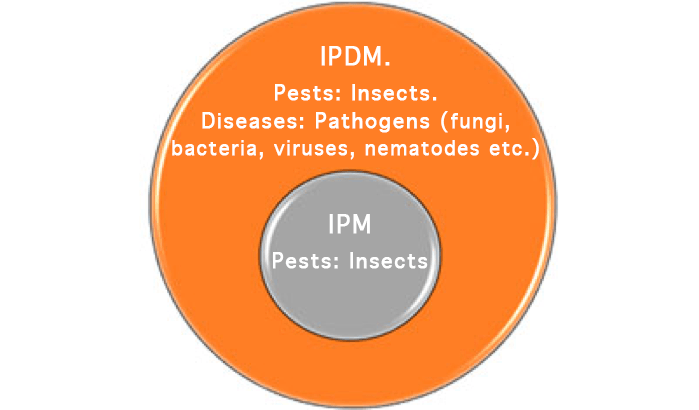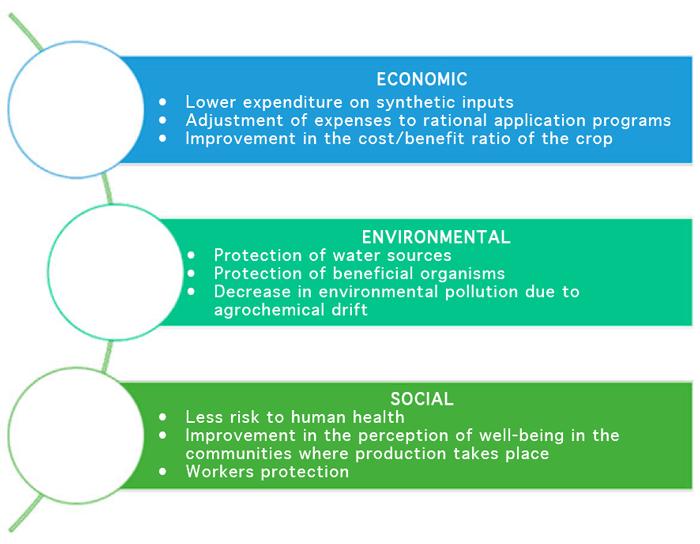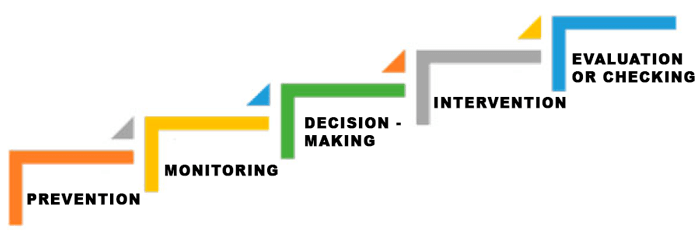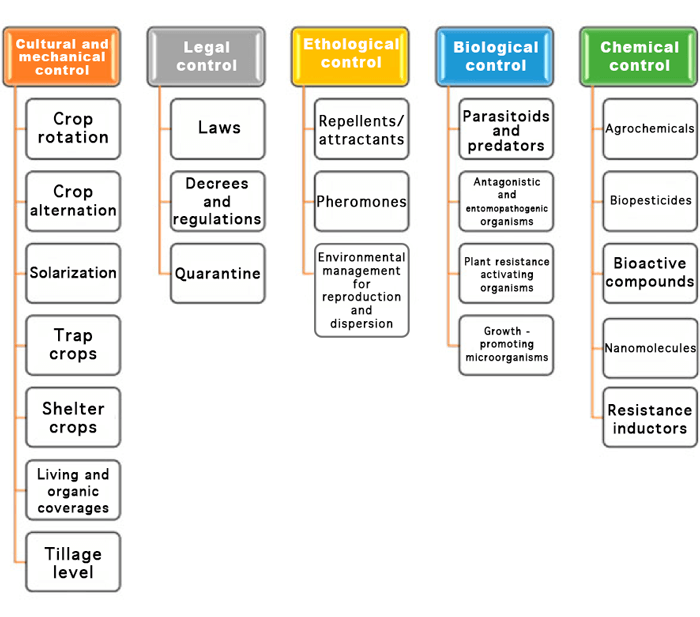Integrated Pest Management: Focus on production responsibility
Biological Control Laboratory.
Concept
Integrated management is a pest control approach that seeks to harmonize efficiency in protection and socio-environmental responsibility measures and in productivity. There are many ways to define it, but all focus on the use of control tools that seek to minimize the losses of a crop through the producers' scientific knowledge, technological support and common sense.
Historically, it is a term established since the 70s (Geier, 1970), although since the 50s many entomologists and biologists have introduced the approach to pest control based on ecological knowledge. The release of the book entitled "The silent spring" by Rachel Carson (1962), which exposed many adverse effects of the use of chemical pesticides in the environment and human health, was a definitive boost to change the paradigms around the way of controlling insects and crop diseases.
Integrated pest management (IPM) is not a new term, but it has become very important in the last two decades, due to the environmental challenges posed by global food, the generation of agricultural jobs, the protection for workers and end consumers, the reduction of the agricultural area and the risks of poisoning or contamination of water sources. In addition, after almost 50 years, there are many successful experiences generated in different parts of the world and in various agro-ecosystems (Parsa et al., 2014, Owen et al., 2015, Lefebvre et al., 2015). And the unsuccessful experiences have contributed to the improvement and adaptation of the many accumulated ideas and intents.
A concrete definition and one of the most accepted worldwide is given by the International Organization for Biological Control (OICB), where it is said that IPM stands for "the use of all economic, ecological and toxicological defense methods to maintain harmful organisms under economic damage levels, while emphasizing the conscious exploration of natural control factors" (Boller et al., 1999).
Extension of IPM to IPDM and current concept
FAO is currently conceptualizing integrated pest management as "careful consideration of all available control techniques and the subsequent integration of appropriate measures that discourage pest population development and maintain the use of pesticides and other interventions at economically justified levels, reducing or minimizing risks to human health and the environment. IPM emphasizes the growth of a healthy crop with the least possible disruption to the agro-ecosystem and encourages natural pest control mechanisms" (WHO / FAO, 2015).

Initially, "integrated management" was directed towards pest control, but as the years have passed, this concept has also been extended towards combating disease in crops. So many researchers today prefer to talk about IPDM (integrated pest and disease management) to show a broader approach that integrates these two aspects of production (Ciancio and Mukerji, 2010). In this way, we may mention both Integrated Pest Management (IPM) or Integrated Pest and Disease Management (IPDM).
Why IPM?
There are many reasons why an IPM system should be implemented in a crop. These can be grouped into economic, social and environmental motivations.

Apart from the above, each agro-ecosystem and each producer can find other reasons and advantages to implement IPM in their crop.
How can the IPM be implemented?
Integrated Management begins with the knowledge of pests and diseases by farmers and agricultural technicians or extension agents. Knowing in detail the causal agent of a disease or an insect is the key to determine the control strategies to implement. This knowledge should be sought either through observation, experimentation, or consultation with experts.
The process for establishing the IPM consists of five stages, each of equal importance. The first is a stage of prevention, which establishes measures that seek to establish the pest or disease within the crop and that they find a suitable environment for reproduction and dissemination.
Once the presence of the pest or the causal agent of the disease is verified, a monitoring system must be established, allowing one to know the levels of presence. Here, it is important to make use of the economic damage thresholds that have been set by the experts or those that have been determined based on the farmer's experience.

Monitoring data on the basis of the decision-making process is a step in which one decides which correction strategy can be applied in case the thresholds have been exceeded, or in case there is evidence for the prediction and significant damages in the crop.
The intervention corresponds to the series of control activities that are implemented so that the pest level or the incidence of the disease are placed once again below the threshold of economic damage. Depending on these levels, the intervention should be more or less rigorous. It is important to mention that the intervention may contemplate the use of agrochemicals, but that is not the only tool available.
The last step is the evaluation of the effectiveness of the intervention measures carried out. Generally, a new monitoring is carried out to determine the success of the control activities executed. This verification stage determines whether further control measures should be carried out or preventive measures should be taken again.
Defense integrated strategies
There are a number of tools that farmers can use to establish an appropriate integrated management in their crop (Stenberg, 2017). These can be grouped into various combat strategies, which vary in their degree of impact on the agroecosystem.
It is important to remember that one of the fundamental ideas of IPM is that the use of agrochemicals is the last resort to be used, since its effects and risks are higher than the other strategies. This means that the use of these inputs must be a decision taken by producers in a framework of social and environmental responsibility, and in pursuit of their economic stability.
The options of tools are ample and of a very varied nature, not limited to those shown in the following list. In addition, farmers themselves can use their own techniques based on experience and observation of the behavior of all elements of their productive system.

The integrated management of pests and diseases has demonstrated over the years its effectiveness in controlling phytosanitary problems, environmental sustainability and productivity. If it walks hand in hand with adequate technical, scientific and technological knowledge, it becomes a way to achieve farmers' productive goals of farmers, while looking after workers, communities and the environment's health.
Biography
- Boller, E. F., El Titi, A., Gendrier, J. P., Avilla, J., Jörg, E., & Malavolta, C. (1999). Integrated production: principles and technical guidelines. OILB. SROP. OICB.
- Carson, R. (2002). Silent spring. Houghton Mifflin Harcourt.
- Ciancio, A., & Mukerji, K. G. (Eds.). (2010). Integrated Management of Plant Pests and Diseases. Springer.
- OMS/FAO. (2015). Código internacional de conducta para la gestión de plaguicidas. Roma. 41P.
- Geier, P. W. (1970). Organizing large-scale projects in pest management, in Meeting on Cotton Pests, Panel of Experts on Pest Control, FAO, Rome. 8 P.
- Lefebvre, M., Langrell, S. R., & Gomez-y-Paloma, S. (2015). Incentives and policies for integrated pest management in Europe: a review. Agronomy for sustainable development, 35(1), 27-45.
- Parsa, S., Morse, S., Bonifacio, A., Chancellor, T. C., Condori, B., Crespo-Pérez, V., & Sherwood, S. G. (2014). Obstacles to integrated pest management adoption in developing countries. Proceedings of the National Academy of Sciences, 111(10), 3889-3894.
- Owen, M. D., Beckie, H. J., Leeson, J. Y., Norsworthy, J. K., & Steckel, L. E. (2015). Integrated pest management and weed management in the United States and Canada. Pest management science, 71(3), 357-376.
- Stenberg, J. A. (2017). A Conceptual Framework for Integrated Pest Management. Trends in Plant Science, 22(9), 759-769.















